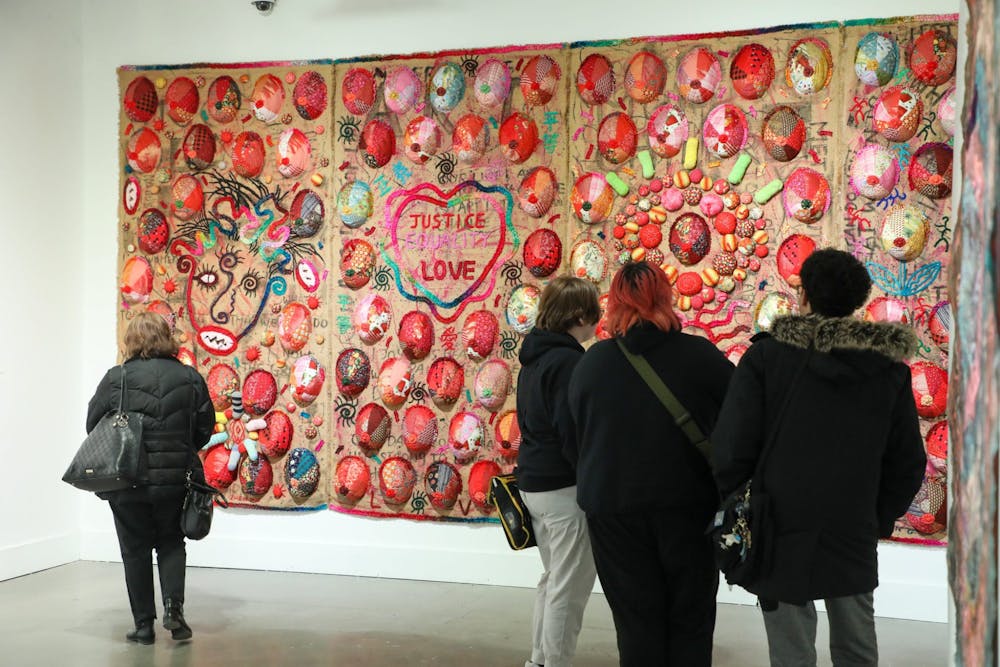By Sky Pinkett
Staff Writer
An ancient art form found itself displayed with fresh interpretations in the College’s new Art Gallery exhibit, “Dancing with the Qi: TransMediating Chinese Calligraphy.”
Qi (pronounced “key”) is the energy of artistic creativity, and shares a rich history as old as the art form of calligraphy itself. On Feb. 5, both took center stage in the visual works of six Chinese artists: Cui Fei, Zhen Guo, Sin-ying Ho, Huang Xiang, Xin Song and Yin Mei.
Altogether, the works from the six artists made for a diverse showcase of Chinese calligraphy in all its glory. Viewers could walk inside the College's Art Gallery and be welcomed by three 30-foot long paintings by artist Mei, all featuring an array of colors, brushstrokes and emotions, or could turn to the right and find themselves towered by Guo’s visual dream of embroidery, fabric and multimedia objects.
Around the corner stood the work of 84-year-old poet Xiang, whose bold calligraphy drew the eyes of all in the room. Xiang’s work was as striking as his own life, as he was both revered and expelled, imprisoned and celebrated throughout his life for his tireless efforts to amplify human rights in China.
(Andre Paras / Video Editor)
The showcase began with opening remarks from curator Jia-Yan Mi, associate professor of Chinese and English at the College. Mi invited the crowd to sit and enjoy a musical performance by Yun Wang to start off the show.
Wang began with an ancient Chinese composition that is about 5,000 years old called “Raining in the Mountain.” Playing on an instrument called Gu Qin, Wang enthralled the crowd with haunting tones set against a pre-recorded audio of nature sounds.
Wang’s second composition was entitled “Falling Water.” Wang explained how “Falling Water” was selected by UNESCO in 1977 as an example of intangible cultural heritage, standing as a voice of the earth in efforts to connect with any life in the universe. It was the only instrumental musical composition that was selected for this task.
After Wang’s performance, dancer and visual artist Mei treated the crowd to an interpretive dance called “Yellow Women” set against a wide white sheet of paper, on which she spread paint and charcoal using her body movements. On the white sheet was a projection that became muddled with Mei’s painting, so much so that it was challenging to read the social commentary and history being projected.
Mei’s performance was meant to convey the fraught history of Chinese women, as well as the struggles they still face today. Taking turns dancing, standing still, and even convulsing on the ground, Mei certainly expressed the emotional weight of her subject matter.
Following Mei’s performance was an artist panel. Dean of the School of Arts and Communication Pamela Barnett opened up the segment with comments on how the works related to the department’s mission.
“School of the Arts and Communication enshrines our core values of creativity and communication, and this is an exhibition that really manifests those values,” Barnett said.
Speaking specifically on the art of calligraphy, she went on to say, “You see evidence of a rigorous and expressive creative practice.”
Curator Mi brought the ancient form of calligraphy into a modern context when he asked all the artists to relate their opinions on artificial intelligence in terms of the art world and their own craft.
“As AI becomes increasingly capable of generating art, we must ask what remains uniquely human of artistic expression. Is AI a collaborator, a tool, a competitor, or a part of the creative process?” Mi proposed.
Guo answered first with, “We need to be aware of our human needs, and human nature…There’s a lot of things that the process, particularly material based process, is very hard to replace.”
Mei gave a very simple yet powerful affirmation, saying, “If there is room for humans to exist, then there will always be human expression.”
The conversation turned to Xiang next. Despite speaking in his native language and using Mi as a translator, Xiang captured the crowd’s understanding with his expressive body language and large gestures.
“My creativity does not isolate in a cave. My paintings, calligraphy, and art are poetry.” Speaking in grandiose metaphors, Xiang went on to say, “Transcend, go beyond the thinking of time and space into the universe.”
Ho spoke next, identifying herself to the crowd as an American artist rather than strictly a Chinese artist due to her residence in the U.S. for over 40 years.
“As artists we like new stuff…creating all things different from everybody else…but AI art…you have to talk to it to get what you want. It cannot paint, it cannot draw,” Ho said.
Fei gave a new take on the topic of AI. “For me, I think AI is a tool. So now it's pretty new and I want to see what it will do in the future.”
Speaking in the last few minutes of the panel, Song agreed with Fei’s view of AI as a tool, as she uses technology on a regular basis for her lemon glass, metal and glass stain works.
“I’m not against it,” she said. “I’ve been using technology in my work…I feel that technology is okay for me because I think the artist needs to be always learning new things and not get so upset…it’s just a tool for me.”
The artists’ various responses gave an overall hopeful view for the future of art, and the role humanity plays in its creation and authenticity.
Speaking on the overall exhibit, Barnett said, “You have this rigorous and expressive creative practice, and calligraphy communicates both visually and textually. So we see the exhibition as very close to the values that we hold as a school.”
The exhibit will remain open to the public through March 13. Check the gallery’s hours to plan your visit to this culturally enriching experience.







